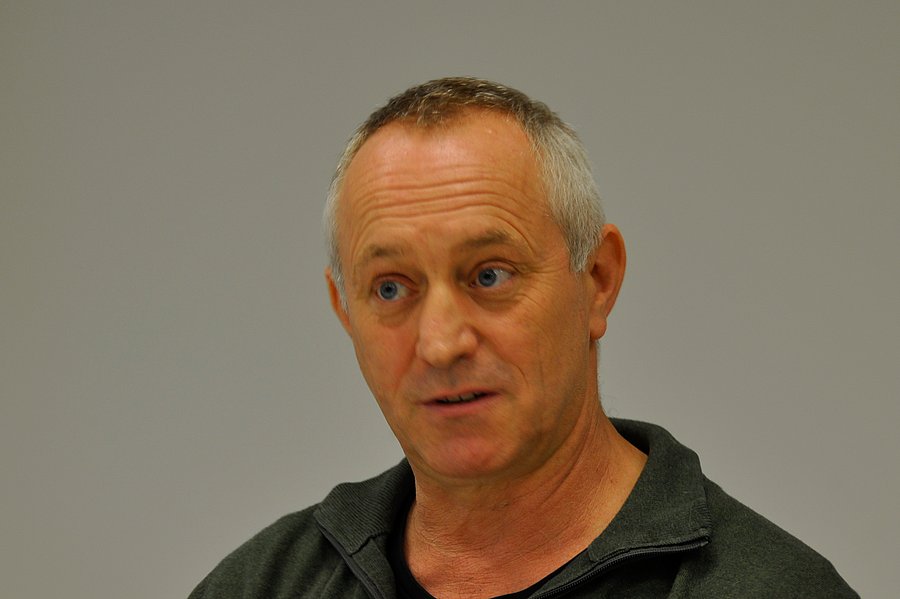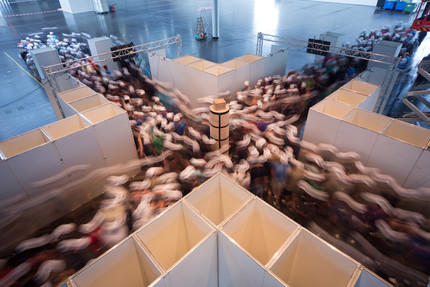
Prof. Dr. Armin Seyfried / Computer simulation for fire protection and pedestrian traffic
Photo: UniService Transfer
Tracking the crowd
Prof. Dr. Armin Seyfried researches pedestrian flows
Everybody knows it: You have planned a journey and now you are standing in the crowded station hall, surrounded by numerous people walking in front of, behind and around you, looking for a ticket, a magazine, a snack, information or the right platform. At rush hour, it can become a tour de force, which increases even more at the platform due to additional people entering and leaving the train. To counteract this phenomenon, Wuppertal physicist Prof. Dr. Armin Seyfried is researching the complex dynamics of pedestrian flows in his teaching and research area of computer simulation for fire protection and pedestrian traffic. "In simple terms, it's all about traffic jam research in pedestrian flows," says the Erlenbach-born physicist. These congestions occur both in local and long-distance public transport, as well as at major events, where the aim is to guide several thousand people safely to an event location in a relatively short time. "If, for example, we want to organize an event for 10,000 people, then you have to see how to get them in and out of the event space. The question that then arises is: When will there be a traffic jam? We are developing methods to be able to predict this system or traffic jam and to be able to estimate how long the admission times will be". Although there are already various empirical values, "but the Love Parade in Duisburg made it painfully clear to us that our current knowledge is not sufficient." The current research in this area is minimal worldwide, Seyfried notes, there is only a hand-picked selection of researchers who are working on it, "and the results so far," he says, "are incredibly diffuse and in no way consistent. There is still an incredible amount to do."
Before Corona our stations were completely overcrowded in certain places
The pandemic has caused mass events to fade into the background, but pedestrian safety measures also play an important role in urban areas. Although public transport is not as congested as it was before Corona, because many people work in home offices, but it has to be said that stations were completely overloaded in places until March of this year. And this also applies to the main station in Wuppertal. "If the station is really running at full load and then has construction work like the one currently in progress, with the tunnel as a central element, then you can already imagine what traffic jams normally mean. If you then look at our platform five, which can only be reached via the stairs leading up and consider the consequences of reaching the track before Corona at peak times, then directing pedestrian flows has a very important function."
Experiment with 1000 test persons
Decisive for the biggest experiment that Seyfried and his team did was the Love Parade incident mentioned above. Seyfried comments: "One of the many problems of the Love Parade was the place where the floats ran along this ramp, where visitors came and went and crossed the floats. So you had a crossing traffic or crossing stream where pedestrians came from all directions. And nobody knew anything about that."
In cooperation with the Forschungszentrum Jülich, his teaching and research department simulated a crossing stream with 1000 test persons in the exhibition halls in Düsseldorf. With the participation of 50 scientists and helpers, with a network of 24 cameras, the experiment was recorded over five days under different conditions to find out when a traffic jam occurs. Since there are no standards to follow, Seyfried and his team also developed new evaluation methods. "The evaluation is still going on today and we keep learning more because it is a complicated system. Every image had to be glued together and evaluated. That is quite an effort!"

Individual jostling behavior
In Wuppertal, Seyfried and Dr. Sieben from the Ruhr University Bochum experimented for the first time with a new question on the behavior of people who are standing in front of an entrance in a traffic jam. "For the first time, we conducted experiments with a social psychologist. As traffic researchers, we are more interested in the facts, i.e. how much space and free space the pedestrian needs and his or her specific speed. But pedestrians are of course also characterized by different behavior."
The question, if we stand in front of an entrance in a traffic jam, when do we start to jostle?' is a completely different question than 'when does a traffic jam occur?' Seyfried simulates different queue systems and varies the width of the ordered rows to see how this affects the jostling behavior. "There are of course many other factors as well. Everything that makes us up, age, gender, size, fan or no fan, sunshine, etc., everything plays a role," he explains, but "of course, you can't study everything at the same time. We have to limit and cut the system. That's what science is all about, that in the end you have reproducible results. That's why we only varied the width there and worked with students as test persons.
The supercomputer is located in Jülich
For the computer simulations, he needs a so-called supercomputer and works closely with the Institute for Advanced Simulation at Forschungszentrum Jülich. "In Jülich, there is a group that deals with the modelling and simulation of flows of people", he explains, and since a computer model can only be as good as the experimental experience gained, the models simulated in Jülich are based on the experiments developed by the Wuppertal researchers. "So the point is to teach the computer program how to turn a non-dragger into a dragger. We find out these parameters through the experiment and then the modelers at Jülich think about how to transfer this into a mathematical model that can then be calculated by the computer." The results would be constructed tools that would enable a planner of a major event to predict a traffic jam. In addition, another group at Jülich works with sensors that translate video data from the experiments very precisely into walking routes.
CroMa - a current project
Seyfried's current project, "Crowd Management in Transportation Infrastructures", or CroMa, also deals with the translation of video data into unpersonalized routing information. In cooperation with the German as well as the Swiss Federal Railways, the researcher explains that "this cooperation is very diverse. For example, video camera systems that detect the paths of people rather than images, are currently being developed at some train stations. We use this data to determine when a station is still functioning and when it is no longer safe, developing processes that measure the quality of waiting and entering and leaving the station." From experience, everyone knows that places near the stairs are preferred waiting areas. This is where one could consider how a platform could be redesigned to equalize these situations. He enumerates that "attractive waiting areas a little further away from the conurbation, timetable information away from waiting areas, or no trash cans in highly frequented areas" are also financially realistic options that are being discussed with Deutsche Bahn. "There are platforms in Frankfurt that are now empty. There are no more seats because they know that otherwise it won't work. And we provide them with scientific support." Also interesting are so-called filling indicators on the information boards in the track area, which are currently being tested. Travellers can use them before the train enters the station to find out which wagon is particularly heavily occupied and decide in advance which wagon to choose.
Corona requires new parameters
In addition to the extensive challenges to avoid congestion, the pandemic adds additional parameters that must be considered: Distance and hygiene. Seyfried has an interesting example of this on which one of his doctoral students, Mira Küpper, is working. "Mira Küpper had already looked at a train station in Switzerland before Corona. Since mid-2019, we have had continuous information from this station that shows how everything there has changed. We can see how the Corona measures have affected the movement of people. And we are currently trying to quantify this with methods. In Switzerland, the situation was that, at first, there was no obligation to wear a mask, but a two-meter distance, then the obligation to wear a mask was demanded with a minimum distance of one meter fifty. So it goes back and forth. There are always demands that change everything. We are curious to see if this can be seen in the data."
Armin Seyfried works with his methodical determination on security standards in everyday situations for all citizens and meets with a lot of understanding. "The nice thing about this topic is" he sums up, "that we all have our personal experiences with it, immediately have our own situation in mind and also an idea of what this research means. And that's what I enjoy doing right now."
Uwe Blass (Interview on 23.09.2020)
Armin Seyfried studied theoretical physics at the University of Wuppertal, received his doctorate and did research in particle physics. Since 2004, Seyfried has been working at Forschungszentrum Jülich to improve safety concepts and carried out experiments with people for the first time. Seyfried is a professor at the University of Wuppertal, where he heads the teaching and research area of computer simulation for fire protection and pedestrian traffic.
